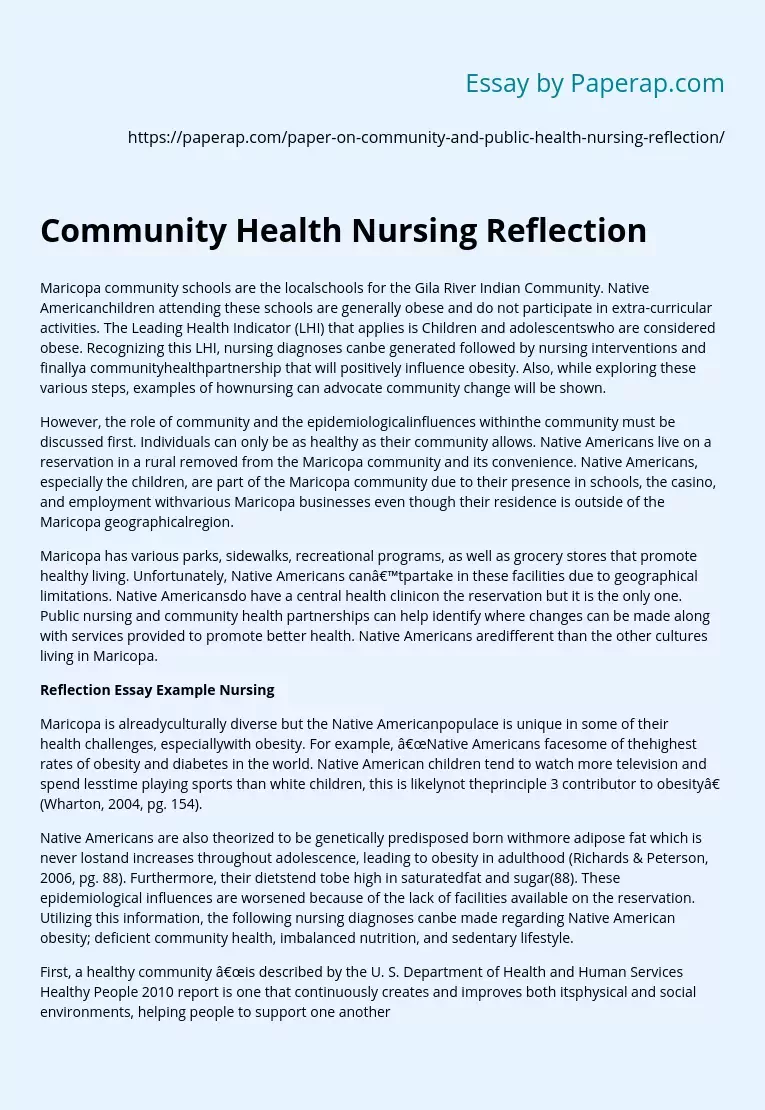Maricopa community schools are the localschools for the Gila River Indian Community. Native Americanchildren attending these schools are generally obese and do not participate in extra-curricular activities. The Leading Health Indicator (LHI) that applies is Children and adolescentswho are considered obese. Recognizing this LHI, nursing diagnoses canbe generated followed by nursing interventions and finallya communityhealthpartnership that will positively influence obesity. Also, while exploring these various steps, examples of hownursing can advocate community change will be shown.
However, the role of community and the epidemiologicalinfluences withinthe community must be discussed first.
Individuals can only be as healthy as their community allows. Native Americans live on a reservation in a rural removed from the Maricopa community and its convenience. Native Americans, especially the children, are part of the Maricopa community due to their presence in schools, the casino, and employment withvarious Maricopa businesses even though their residence is outside of the Maricopa geographicalregion.
Maricopa has various parks, sidewalks, recreational programs, as well as grocery stores that promote healthy living.
Unfortunately, Native Americans can’tpartake in these facilities due to geographical limitations. Native Americansdo have a central health clinicon the reservation but it is the only one. Public nursing and community health partnerships can help identify where changes can be made along with services provided to promote better health. Native Americans aredifferent than the other cultures living in Maricopa.
Reflection Essay Example Nursing
Maricopa is alreadyculturally diverse but the Native Americanpopulace is unique in some of their health challenges, especiallywith obesity. For example, “Native Americans facesome of thehighest rates of obesity and diabetes in the world.
Native American children tend to watch more television and spend lesstime playing sports than white children, this is likelynot theprinciple 3 contributor to obesity” (Wharton, 2004, pg. 154).
Native Americans are also theorized to be genetically predisposed born withmore adipose fat which is never lostand increases throughout adolescence, leading to obesity in adulthood (Richards & Peterson, 2006, pg. 88). Furthermore, their dietstend tobe high in saturatedfat and sugar(88). These epidemiological influences are worsened because of the lack of facilities available on the reservation. Utilizing this information, the following nursing diagnoses canbe made regarding Native American obesity; deficient community health, imbalanced nutrition, and sedentary lifestyle.
First, a healthy community “is described by the U. S. Department of Health and Human Services Healthy People 2010 report is one that continuously creates and improves both itsphysical and social environments, helping people to support one another in aspectsof daily life and to develop to their fullest potential” (Healthy Places). In order toaddressthe deficient community health, a communityhealthevent could be planned thatchecksweight, height, cholesterol and blood glucose levels.
Also, at this event, education about health promotion and diseaseprevention would be beneficial in addressing the diabetes and obesity so prevalent within the Native American populace. Imbalanced nutrition can be because the body is not getting enough nutritional vitamins and minerals or because thebody is getting too much fat and sugar intake.
Due to the high volume of Native American children in the Maricopa school system and the poor economic status of many Native American families, schools need to provide healthy meals for students. Furthermore, the school could also monitor lunches brought in by students and provide healthy alternatives. Also, if an after school program is developed; a dietician could provide healthy food options such as snacks, food education materials like calorie sheets, meal planning, and food alternatives for families. Sedentary lifestyle can be changed by implementing an after school program.
Different activities, games, and sports 4 would be provided which would encourage exercise, socialization, and safety. This time could also be utilized toteach different games and sports that can be done at home. Involving the Native American community to change their habits would be best done by collaborating with Native American leadersand health professionals. Native American leaders would be excellent role models for children and the community as a whole. Collaborating with the Maricopa community would also generate interesting cross-cultural health events and activities.
Also, during these events, culture could be promoted in a healthy way such as traditional Native foods prepared in a healthy way and cultural dancing encouraged. Another resource would be to contact Community Partnership of Southern Arizona. They provide healthcare clinics, have people available to answer community specific questions, provide referrals to services, and have a directory of community resources that are available. Obesity is the LHI of Native American children living just outside Maricopa but attending school within the Maricopa School District.
The Reservation’s distance from Maricopa community facilities along with dietand epidemiological factors like diabetesall contribute to Native Americanobesity. By combating deficient community healthwith a community health event, educating and correcting imbalanced nutrition at the school, and eliminating a sedentary lifestyle by implementing an after school program, changes can be made. The Native Americancommunity will respond to Native leaders encouraging change. Culture eventssuch asfestivalswould be an excellent opportunity toimplement and highlight some of these healthychanges.
References
- Centers for Disease Control and Prevention. (2000). Healthy places. Retrieved from http://www. cdc. gov/healthyplaces/about. htm#Healthy%20Env
- Richards, T. J. , & Patterson, P. M. (2006, August). Native American obesity: An economic model of the “Thrifty Gene” theory. American Journal of Agricultural Economins, 88(3), 542-560. Retrieved from http://www. jstor. org/stable/3697748
- Wharton, C. M. (2004). Beverage consumption and risk of obesity among native americans in arizona. Nutrition Reviews, 62(4), 153-9. Retrieved from http://search. proquest. com/docview/212348616? accountid=458
Community Health Nursing Reflection. (2019, Dec 05). Retrieved from https://paperap.com/paper-on-community-and-public-health-nursing-reflection/

